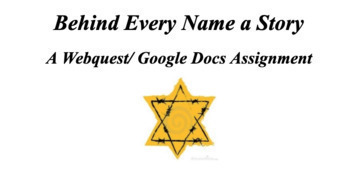"Behind Every Name a Story" Holocaust Survivor Research and Writing Project
Supportive Supplements
7 Followers
Grade Levels
Not Grade Specific
Resource Type
Standards
CCSSRH.9-10.1
CCSSRH.9-10.2
CCSSRH.9-10.3
CCSSRH.9-10.4
CCSSRH.9-10.6
Formats Included
- Google Docs™
- Easel Activity
Pages
2 pages
Supportive Supplements
7 Followers

Made for Google Drive™
This resource can be used by students on Google Drive or Google Classroom. To access this resource, you’ll need to allow TPT to add it to your Google Drive. See our FAQ and Privacy Policy for more information.
Easel Activity Included
This resource includes a ready-to-use interactive activity students can complete on any device. Easel by TPT is free to use! Learn more.
What educators are saying
This was a great project for my 8th graders to do at the end of our Holocaust unit. Very eye opening for them. They were very engaged and interested in the person they were researching.
Perfect addition to our Holocaust unit! It's my first time teaching this unit, and this resource helped me tremendously!
Description
Through this activity, students view the Holocaust through the eyes of the people who witnessed this event. Through their stories, students can gain a better appreciation for the struggles and strength demonstrated by those impacted by the Holocaust.
This webquest/ Google Doc assignment allows students to use the "Behind Every Name a Story" page of the United States Holocaust Memorial Museum to research and write about the experiences of a Holocaust survivor. Through the site, students can select one of several survivor stories. On the Google Doc assignment, students will write about their chosen survivor's experiences, and reflect on the challenges faced by the survivor.
Total Pages
2 pages
Answer Key
N/A
Teaching Duration
1 hour
Report this resource to TPT
Reported resources will be reviewed by our team. Report this resource to let us know if this resource violates TPT’s content guidelines.
Standards
to see state-specific standards (only available in the US).
CCSSRH.9-10.1
Cite specific textual evidence to support analysis of primary and secondary sources, attending to such features as the date and origin of the information.
CCSSRH.9-10.2
Determine the central ideas or information of a primary or secondary source; provide an accurate summary of how key events or ideas develop over the course of the text.
CCSSRH.9-10.3
Analyze in detail a series of events described in a text; determine whether earlier events caused later ones or simply preceded them.
CCSSRH.9-10.4
Determine the meaning of words and phrases as they are used in a text, including vocabulary describing political, social, or economic aspects of history/social studies.
CCSSRH.9-10.6
Compare the point of view of two or more authors for how they treat the same or similar topics, including which details they include and emphasize in their respective accounts.



